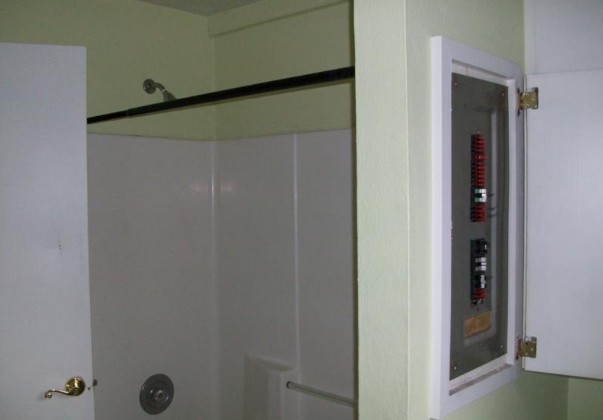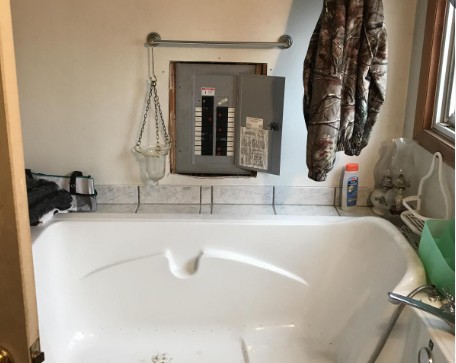When it comes to electrical installations, safety and adherence to electrical codes are paramount. One area in your home that could raise concern is the bathroom, which might cause you to ask, “Can a breaker box be in a bathroom?”
You cannot install breaker boxes and other overcurrent devices in your bathroom, citing safety risks. Additionally, the compact size of residential bathrooms limits the clearance space around your breaker box, which compounds the safety concerns surrounding its placement in restrooms.
This post encompasses reasons not to have a breaker box in a bathroom, exceptions, and what to do if you already have one.

Can A Breaker Box Be In A Bathroom? (Reasons Not To)
Here are reasons contractors discourage you from incorporating a breaker box in a restroom:
1. Safety Hazards
Bathrooms are inherently high-moisture environments because of activities like bathing, showering, and handwashing. Water and electricity are a dangerous combo.
Therefore, placing a breaker box in such close proximity to water fixtures significantly increases the risk of short circuits and electrical shocks. The two pose a dreadful threat to your household’s safety.
2. Fire Risks
A breaker box features electrical and wiring circuits that generate heat. Therefore, installing a breaker box in a restroom increases the likelihood of water splashing onto the electrical components, which leads to electrical malfunctions and, in worst-case scenarios, fires.
Moreover, the breaker box-water combination induces corrosion and damage.
3. Space Limitations
Another reason home improvement experts discourage integrating a breaker box in a bathroom is space restrictions. Typically, bathrooms tend to be smaller in size compared to other areas.
The building codes mandate 36x30x78 spacing around the breaker box, a requirement most restrooms fail to meet. Therefore, installing a breaker box in a confined space could limit accessibility and hinder the ability to maneuver around the electrical panel.
You should include sufficient clearance for technicians to perform their tasks efficiently.
4. Electric Code Compliance
The National Electric Code and other local electrical codes strictly regulate the installation of breaker boxes to ensure your safety. The regulations mandate installing breaker boxes in dry, well-ventilated areas.
Violating this code could land you in trouble with the authorities and void your insurance coverage.
Cases That Allow Installation Of A Breaker Box In A Bathroom
As much as NEC prohibits mounting breaker boxes in bathrooms, some settings received approval from the local authorities. They include:
1. Public Bathrooms
It might come as a surprise, but NEC doesn’t prohibit integrating breaker boxes in public bathrooms or what you know as commercial bathrooms. This is despite the higher probability of accidents occurring in such environments.
To some degree, the absence of specific regulations regarding breaker box installations in public bathrooms raises questions about the rationale behind the National Fire Protection Association’s (NFPA) decision.
It’s worth mentioning that codes are subject to periodic updates and revisions. While the NEC does not address the issue of breaker boxes in public bathrooms, it is plausible that future revisions may rectify this practice and provide comprehensive guidelines for ensuring electrical safety.
2. Large Residential Bathrooms
The NEC guidelines advocate for a dedicated space surrounding the breaker box with dimensions of at least 36 inches long, 30 inches wide, and 78 inches high. This is done to ensure proper accessibility and safety.
If your bathroom has sufficient room to accommodate this clearance, you can proceed to mount the breaker box.
Compliance with the recommended clearance facilitates optimal functionality and ease of maintaining the electrical panel within your bathroom space.
3. Bathroom Constructed Before NEC Enactment
While you will be hard-pressed to know the exact year the NEC guidelines came into play, some home improvement experts will tell you it was 1993. The enactment found bathrooms featuring breaker boxes already in place.
At the time, it would be unreasonable for NFPA to compel you to do away with the breaker box bathroom. Besides, the authority did not outlaw the inclusion of such fixtures in restrooms (behind the toilet) as illegal.
Adhering to the NEC regulations despite having an old bathroom will keep your household safe.

What Should You Do If You Have A Breaker Box In The Bathroom?
If you installed a breaker box in the restroom before knowing about NEC regulations, the following tips would ensure your safety:
1. Cover The Electric Panel With Gasket Seal
Using a gasket seal is a budget-friendly way of creating a waterproof barrier between the breaker box and the humid bathroom surroundings. It prevents water from splashing into the panel, thus reducing the risk of electrical malfunctions and accidents.
Installing a 100-pack Birllaid Foam Outlet Insulation Gasket Seal (View on Amazon) adds a layer of protection to the breaker box. This product seals off tiny warm or cold air draughts flowing through electrical wall switches and outlets.
2. Create More Bathroom Space
Another reason NEC advises you against installing a breaker box in your restroom is the limited space. Most bathrooms are compact and fall short of the 36x30x78 threshold around the panel.
Therefore, consider creating alternative storage solutions such as wall-mounted cabinets and shelves to store towels, toiletries, and other bathroom essentials. You could also employ vertical space and storage baskets to declutter the area around the circuit breaker box.
Alternatively, examine the current bathroom layout to see whether you can optimize the space. For instance, you may want to rearrange the sink, the bathtub, or the toilet to create a design that will accommodate the breaker box seamlessly.
As you remodel the restroom, remember to stick to the building regulations.
3. Reverse The Circuit Breaker Box
Homeowners will tell you that reversing a breaker box is the most cost-efficient method of protecting the electrical appliance from moisture. It entails uninstalling the panel and relocating it against the wall.
Before reversing the box, you should consider accessibility, wiring, and safety precautions which require electrical expertise.
4. Install A Waterproof Circuit Breaker Box
Another way of preventing electrical malfunctions and accidents in your bathroom is by adopting a waterproof breaker box. The panel features a sealed enclosure that keeps water away from it.
An example of a waterproof circuit breaker box is the Flameer Circuit Breaker Distribution Box, which is easy to install and fits inside multiple bathroom walls. It is a viable option, despite some considering it outdated.
5. Change The Circuit Breaker Box To A Mass Junction Box
This approach is ideal for cases where expanding the bathroom space is not feasible. It involves using a conversion kit to convert an installed circuit breaker box into a watertight mass junction box.
The mass junction box allows the joining of multiple circuits in one spot, creating a centralized location for electrical connections. It is a safe and effective way of managing a bathroom electrical system in a limited space.
All you have to do is switch off the power to the box and remove the circuit breakers. Ensure that you only leave the main breaker intact. Next, install a large junction box to accommodate the number of circuits you need to connect.
Feed the wires from the breaker box into the junction box and connect them using wire nuts. After that, install a new cover on the breaker box, and label it as a “Junction Box.”
Where Should You Place A Breaker Box?
The perfect location for installing a breaker box depends on the following factors:
1. Accessibility
The NEC mandates installing the electrical panel in an easily accessible area for maintenance and troubleshooting. An example of such an area is near the service entrance.
Here, you can reach the panel without difficulty, unlike behind furniture or in cramped spaces. It also enhances safety in the restroom.
2. Safety
NEC recommends placing the circuit breaker box at a service entrance to minimize potential hazards. The service entrance encompasses the meter, meter box, and disconnect.
Place the panel 10 inches from the gas meter and other flammable materials to avert fire risks. The spacing applies to water fixtures since water and electricity are sworn enemies.
3. Visibility
Besides accessibility and safety, visibility is another crucial factor when installing a breaker box in an apartment, especially in an area close to or inside the bathroom. The panel should be visible for easy identification during emergencies and power outages.
Consequently, NEC mandates installing breaker boxes in well-lit areas and avoiding concealed spots.

What To Do When Water Splashes On Your Breaker Box?
Water splashing on your circuit breaker box spells doom for your safety. If it happens, follow the procedure below to minimize accidents:
1. Disconnect The Power Supply
Start by cutting off the power supply to your residence to halt the electrical current. It is essential to mitigate potential hazards.
2. Introduce Air Circulation
If possible, introduce airflow around the electrical panel to facilitate evaporation. As you do this, ensure the air is not humid to avoid electrocution.
3. Use Alcohol To Clean
Alcohol is ideal for this process thanks to its dehydration properties; it can remove moisture from the affected area. So, dampen a cloth in a container containing 99% running alcohol and wipe the wet electrical panel gently for optimal results.
4. Alternatively, Use Rice
Rice has dehydrating properties that make it equal to the task if you don’t have alcohol. Take some rice and rub it on the affected area, and allow it to absorb the moisture.
Why Should You Observe NEC Regulations?
Adhering to NEC regulations is paramount when installing a breaker box in a bathroom or an adjacent area for the following reasons:
1. Safety
NEC prioritizes safety from electrical hazards like shocks, electric fires, and other accidents stemming from electrical malfunctions. It specifies proper wiring methods, and clearance requirements, among others.
2. Water Protection
Typically, bathrooms are areas with high moisture levels. For that reason, NEC implemented guidelines to protect electrical equipment from damage.
Final Thoughts On Can A Breaker Box Be In A Bathroom?
Generally, installing a breaker box in a restroom poses a significant risk to you and the panel. The NEC prohibits the practice and only offers a few exceptions.
If you must install a panel in your bathroom, adhere to the safety precautions.
Also, Read:
